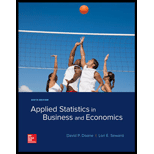
Concept explainers
Find the standard normal area for each of the following, showing your reasoning clearly and indicating which table you used.
- a. P(1.22 < Z < 2.15)
- b. P(2.00 < Z < 3.00)
- c. P(−2.00 < Z < 2.00)
- d. P(Z > 0.50)
a.
Find the standard normal area for
Answer to Problem 16SE
The standard normal area for
Explanation of Solution
Calculation:
Normal distribution:
A continuous random variable X is said to follow normal distribution if the probability density function of X is,
Standard normal distribution:
A continuous random variable Z is said to follow standard normal distribution if the probability density function of Z is,
For a standard normal variable it is known that,
The probability
Calculate the value of
From Appendix C-1: Table “STANDARD NORMAL AREAS”,
- Locate the z value 2.1 in column of z.
- Locate the probability value corresponding to z-value 2.1 in the column 0.05.
Thus,
Calculate the value of
From Appendix C-1: Table “STANDARD NORMAL AREAS”,
- Locate the z value 1.2 in column of z.
- Locate the probability value corresponding to z-value 1.2 in the column 0.02.
Thus,
Hence,
Hence, the standard normal area for
b.
Find the standard normal area for
Answer to Problem 16SE
The standard normal area for
Explanation of Solution
Calculation:
For a standard normal variable it is known that,
The probability
Calculate the value of
From Appendix C-1: Table “STANDARD NORMAL AREAS”,
- Locate the z value 3.0 in column of z.
- Locate the probability value corresponding to z-value 3.0 in the column 0.00.
Thus,
Calculate the value of
From Appendix C-1: Table “STANDARD NORMAL AREAS”,
- Locate the z value 2.0 in column of z.
- Locate the probability value corresponding to z-value 2.0 in the column 0.00.
Thus,
Hence,
Hence, the standard normal area for
c.
Find the standard normal area for
Answer to Problem 16SE
The standard normal area for
Explanation of Solution
Calculation:
For a standard normal variable it is known that,
The probability
From part (b), it is found that
Calculate the value of
From Appendix C-2: Table “CUMULATIVE STANDARD NORMAL DISTRIBTION”,
- Locate the z value –2.0 in column of z.
- Locate the probability value corresponding to z-value –2.0 in the column 0.00.
Thus,
Hence,
Hence, the standard normal area for
d.
Find the standard normal area for
Answer to Problem 16SE
The standard normal area for
Explanation of Solution
Calculation:
For a standard normal variable it is known that,
The probability
Calculate the value of
From Appendix C-1: Table “STANDARD NORMAL AREAS”,
- Locate the z value 0.5 in column of z.
- Locate the probability value corresponding to z-value 0.5 in the column 0.00.
Thus,
Hence,
Hence, the standard normal area for
Want to see more full solutions like this?
Chapter 7 Solutions
APPLIED STAT.IN BUS.+ECONOMICS
- A company found that the daily sales revenue of its flagship product follows a normal distribution with a mean of $4500 and a standard deviation of $450. The company defines a "high-sales day" that is, any day with sales exceeding $4800. please provide a step by step on how to get the answers in excel Q: What percentage of days can the company expect to have "high-sales days" or sales greater than $4800? Q: What is the sales revenue threshold for the bottom 10% of days? (please note that 10% refers to the probability/area under bell curve towards the lower tail of bell curve) Provide answers in the yellow cellsarrow_forwardFind the critical value for a left-tailed test using the F distribution with a 0.025, degrees of freedom in the numerator=12, and degrees of freedom in the denominator = 50. A portion of the table of critical values of the F-distribution is provided. Click the icon to view the partial table of critical values of the F-distribution. What is the critical value? (Round to two decimal places as needed.)arrow_forwardA retail store manager claims that the average daily sales of the store are $1,500. You aim to test whether the actual average daily sales differ significantly from this claimed value. You can provide your answer by inserting a text box and the answer must include: Null hypothesis, Alternative hypothesis, Show answer (output table/summary table), and Conclusion based on the P value. Showing the calculation is a must. If calculation is missing,so please provide a step by step on the answers Numerical answers in the yellow cellsarrow_forward
 Functions and Change: A Modeling Approach to Coll...AlgebraISBN:9781337111348Author:Bruce Crauder, Benny Evans, Alan NoellPublisher:Cengage Learning
Functions and Change: A Modeling Approach to Coll...AlgebraISBN:9781337111348Author:Bruce Crauder, Benny Evans, Alan NoellPublisher:Cengage Learning College Algebra (MindTap Course List)AlgebraISBN:9781305652231Author:R. David Gustafson, Jeff HughesPublisher:Cengage Learning
College Algebra (MindTap Course List)AlgebraISBN:9781305652231Author:R. David Gustafson, Jeff HughesPublisher:Cengage Learning Holt Mcdougal Larson Pre-algebra: Student Edition...AlgebraISBN:9780547587776Author:HOLT MCDOUGALPublisher:HOLT MCDOUGAL
Holt Mcdougal Larson Pre-algebra: Student Edition...AlgebraISBN:9780547587776Author:HOLT MCDOUGALPublisher:HOLT MCDOUGAL Glencoe Algebra 1, Student Edition, 9780079039897...AlgebraISBN:9780079039897Author:CarterPublisher:McGraw Hill
Glencoe Algebra 1, Student Edition, 9780079039897...AlgebraISBN:9780079039897Author:CarterPublisher:McGraw Hill Algebra: Structure And Method, Book 1AlgebraISBN:9780395977224Author:Richard G. Brown, Mary P. Dolciani, Robert H. Sorgenfrey, William L. ColePublisher:McDougal Littell
Algebra: Structure And Method, Book 1AlgebraISBN:9780395977224Author:Richard G. Brown, Mary P. Dolciani, Robert H. Sorgenfrey, William L. ColePublisher:McDougal Littell Big Ideas Math A Bridge To Success Algebra 1: Stu...AlgebraISBN:9781680331141Author:HOUGHTON MIFFLIN HARCOURTPublisher:Houghton Mifflin Harcourt
Big Ideas Math A Bridge To Success Algebra 1: Stu...AlgebraISBN:9781680331141Author:HOUGHTON MIFFLIN HARCOURTPublisher:Houghton Mifflin Harcourt





